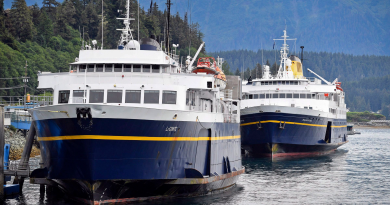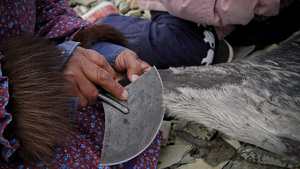Commanding officer testifies how police boat sank in Canadian North

Corporal clung to capsized boat while constable drowned swimming to shore
An inquest in Whitehorse, the capital of Canada’s northwest Yukon territory, has heard from the police officer who survived the capsize that led to the death of Constable Michael Potvin in the Stewart River near the community of Mayo in July 2010.
Corporal Brent Chapman or the Royal Canadian Mounted Police, Canada’s national police force, was in the police boat with Potvin when it capsized.
Chapman had just transferred to Mayo, located in Yukon’s interior, at the time of the incident. He was taking over the detachment after a long career in southern Canada’s prairie provinces. He said one of his first priorities was to fix up the Royal Canadian Mounted Police boat which he described as dirty and old-looking.
Chapman said he had heard concerns about a faulty motor on the boat and water coming over its stern into the boat so he decided to do test runs on the Stewart River close to Mayo. He invited Constable Mike Potvin to come along.
The first run only lasted a kilometre before the boat apparently ran out of gas. Chapman said they used a small auxiliary motor to return to Mayo to refill the tanks.
But shortly after they returned to the water the motor stalled again. Chapman said he restarted it four or five times then stopped, because water coming over the back was flooding the boat.
He started the auxiliary motor but it then died as well.
After a short time drifting, the now-swamped boat rolled over and both men went into the water. Chapman said he stayed with the boat while Potvin tried to swim for shore. It was some time before he found out the constable didn’t make it.
Father questions judgment
There was a tense exchange between Chapman and Potvin’s father, who is representing the family at the inquest.
Mark Potvin questioned Chapman’s judgment during the incident. He wanted to know why the officers steered the swamped boat towards the launch area instead of the closest point of land.
Chapman said he assumed the boat would continue floating upright.
He also told Chapman as commanding officer he had a duty to take care of Michael that day and asked if he did that.
Chapman replied “The short answer is ‘no.'”
Alex Brydon, an expert on boat design, testified that the patrol boat should have stayed upright even when full of water.
Brydon said investigators filled the boat with water to see if it actually would stay upright. In a video played at the inquest, it was not even close to being full when it rolled over.
He said there was too much weight in the stern: the outboard motor on the boat was too heavy and the addition of an auxiliary motor, just weeks before Potvin’s death, made the situation much worse. Holes had been cut in the motorwell that let water coming over the stern flow freely into the main section of the boat. Also, the bilge pump that would have pumped out water was not working and a tiny piece of wood was found partially blocking the fuel line filter.
Brydon said when Chapman went to the back to run the auxiliary, instead the stern sank even further. Brydon said it’s a mystery how the piece of wood came to block the filter. He suspects somebody had earlier used a twig to to clean it out.
Sergeant Blake Ward, an Royal Canadian Mounted Police marine investigator, told the inquest that modifications made to the Mayo police boat over the years were improper and not professionally done.
He said he found evidence of changes to the stern that included the holes in the motorwell. Ward also said the partial blockage in the fuel line filter would have repeatedly stalled the motor.
He also commented on a photo of the boat in the water. Ward said because of the holes in the motorwell, the stern was low, and let water flow directly into the boat.
Ward said the current in the Stewart River would have been difficult for Const. Michael Potvin to swim through on the day he drowned. Ward told the jury the current in that section of the river was probably about 10 km/h.
Potvin was wearing boots and his duty belt with gun when he drowned. He was not wearing a personal flotation device.
Related Link:
Problems with police boat before drowning death in Yukon, Canada, CBC News
For more northern stories from CBC News, click here



